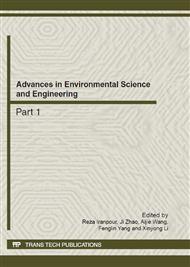p.4321
p.4325
p.4333
p.4337
p.4341
p.4346
p.4350
p.4354
p.4362
Estimation of Environmental Flow Requirements in the Zhangweixin River Estuary, China
Abstract:
Environmental flow requirements (EFRs for short), which considered the requirements for protection of migratory fishes habitat in spawning and larval period, were analyzed in this paper for the Zhangweixin River Estuary (ZRE for short), China. Based on the different levels of salinity objectives and the relationship between salinity and the freshwater inflows, the EFRs for the ZRE were determined. Annual EFRs should be 2.1 × 108 and 9.9 × 108 m3 for the minimum and appropriate levels objectives in the ZRE, respectively. The minimum and appropriate EFRs can be satisfied by 38% and 11% of year’s annual freshwater inflows in the ZRE during 1956-2010, respectively. Moreover, with the freshwater inflows decreasing, the monthly EFRs for the ZRE cannot be fulfilled in longer period of the year. The seasonal discrepancy between the water quantity requirement to meet ecological goals and the practical freshwater inflows was outstanding during longer periods of the 2000s. The periods from March to September should be considered as the critical seasons to maintain the minimum environmental flows in the ZRE.
Info:
Periodical:
Pages:
4341-4345
Citation:
Online since:
May 2012
Authors:
Price:
Сopyright:
© 2012 Trans Tech Publications Ltd. All Rights Reserved
Share:
Citation:


